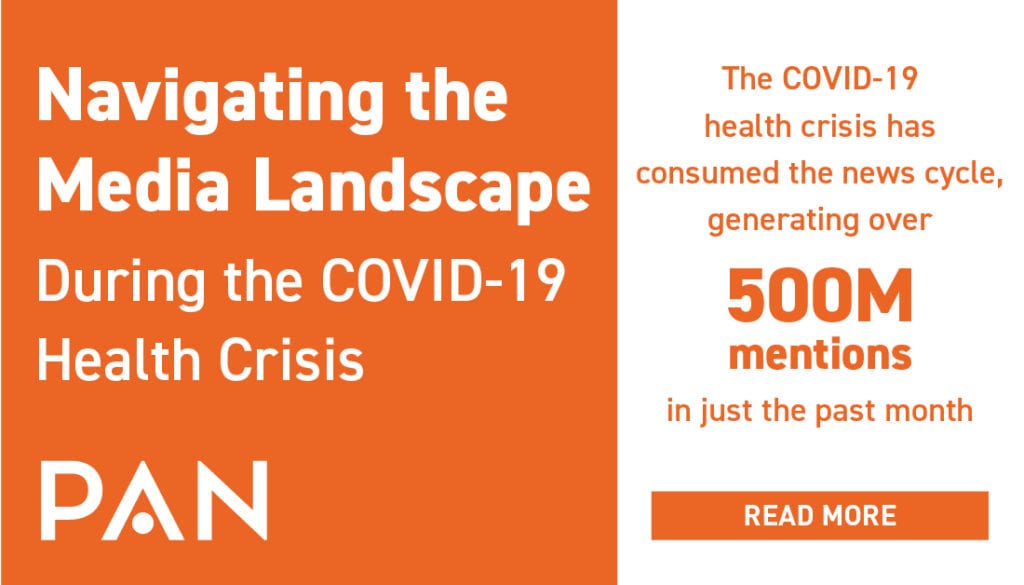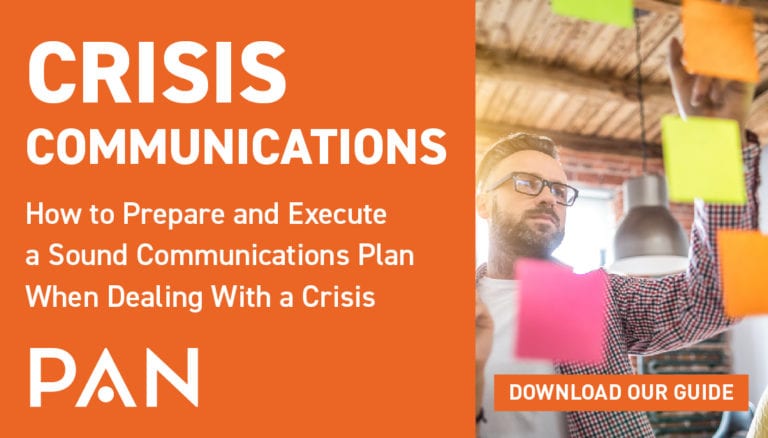During uncertain times, the media landscape can be a challenging – yet vital – place for brands to engage. The COVID-19 health crisis has consumed the news cycle, generating over 500 million mentions in just the past month alone, unseating other major news drivers including the 2020 presidential primaries. For context, that’s a greater number of mentions than AI, customer experience or data privacy and security received over a two-year span.
To say the media is centered on COVID-19 right now is an understatement. So, how and where should brands engage? Is it acceptable to continue promoting products and services in this climate?
Below, we explore some of the intricacies of external communications during times of crisis to help you navigate media opportunities and potential missteps.

5 Media Relations Best Practices to Consider During a Crisis
Know Your Target Audience to Develop an Engagement Strategy
Now more than ever, it is vital to understand your audience. Not just your customers, prospects and employee communities, but media audiences as well. The very best place to gain insight into what the media is interested in and apt to cover next is the web.
Prior to engaging with any reporter – whether they reached out to your company directly, or you are considering contacting them – spend some time reviewing recent coverage, as well as the reporter’s social media feeds. This will give you a sense for what topics they are covering and whether their focuses have changed in recent weeks. It can also give you a sense for how they are covering like-minded brands, what the reporter’s pet peeves might be, and if the reporter is grappling with personal impacts of this health crisis.
This knowledge can help you develop a more sensitive engagement strategy, or decide whether to engage at all. You should also lean on your agency partners for insight at this time. Chances are, we have recently engaged with the reporter in question, have learned from a similar scenario with another client or can advise on the best approach given their view across industries.
Understand the Current News Cycle: What is Trending?
As with any news cycle, COVID-19 crisis coverage will move through news-driven, insight-driven and advice-driven cycles. What is unique about this event, however, is that the news cycle tends to reset as new information enters the discussion.
So, while prior events have followed a specific, time-based path – where we reacted to events, reflected on events, then learned from events – the news-driven aspects of COVID-19 continue to refresh and reset the news cycle.
What does this mean for brands and their communications professionals? It means there is no one-size-fits-all approach to external communications. We need to look at each campaign, each piece of content, and each channel individually, asking: What is required at this time?
To offer an example, last week’s news cycle focused on how COVID-19 is impacting unemployment levels across the country. A news-driven engagement with media would have included sharing reactions to the crisis’ impact on small businesses, while an insight-driven engagement would have looked like sharing unemployment data by sector, or detailed overviews of how and when the stimulus bill would help struggling businesses and individuals. If you can’t think of an advice-driven engagement, it’s because the news cycle hasn’t reached that point just yet. But if you have thoughtful strategies to recommend, this will be your next engagement opportunity.
Thinking through the news cycle on a topic-by-topic basis will present your best approach to information sharing via earned media channels.

Knowing the Difference Between Impactful vs. Sales-Driven
When it comes to determining what messages will resonate and which information to share through the press at this time, ask yourself whether what you are contributing is genuinely helpful to impacted audiences or if it might be viewed as self-serving.
If your message, initiative, product or service is providing relief to communities in need – in the form of support for response efforts, or economic stimulus, for example – then it is probably fine to share with media. However, if your campaign is aimed at spurring sales – now or in the future – but has little relevance to current events, you should wait until the COVID-19 news cycle has calmed or proceed with a highly targeted strategy.
A Conservative Media Approach is Key During a Crisis
If you are like many of our clients here at PAN, you’ve likely announced positive news – fundraisers, mergers and acquisitions, innovative new product offerings – in recent months. And while we are big fans of proactive news outreach, especially during the best of times, navigating the worst of times requires a different approach.
Depending on where you sit in the market, you may be on the front lines of this crisis – navigating business closures, response to outbreaks, major revenue losses or even loss of life. Even if you are isolated from the early impacts of COVID-19, chances are you will feel the economic and personal effects of this event eventually. And if you are among the companies looking at growth during this time, a measured and empathetic approach to sharing success is crucial to maintaining brand reputation.
Engaging with reporters in any of these scenarios requires a thoughtful approach and plenty of preparation. Your executives will be asked about business health during live interviews, they will be asked about sick employees – are they prepared to respond?
Follow your agency’s lead when it comes to how conservative you should be in any scenario. When planning proactive news campaigns, work closely with your agency leads and always consider the “big picture” of your business. For example, if you are considering downsizing your organization, you should not be promoting gains in your industry or your business. Be as open as possible with your agency team to ensure we can do our best work in protecting your brand from potentially negative press.
Set Realistic Expectations for Your Media Outreach
Lastly, with COVID-19 commanding more press mentions in one month than most “hot” topics can hope to achieve in two years, we need to feel empowered as communications pros to manage internal expectations around media coverage.
We’d all love to see our communications machines work at peak efficiency at all times, but the reality is that news channels are responsive by their very nature. A major news announcement that commanded broad press coverage last month might land you only one or two pieces of quality coverage this month. Set expectations accordingly, especially if your news has nothing to do with current events.
Remember, communications during times of crisis should be helpful and thoughtful, not overtly self-promotional. They require a more tailored, thorough and well-researched approach to ensure your message reaches the right reporters and the right audiences for impact.
To learn more about how to craft internal and external communication strategies, download our guide “How to Prepare and Execute a Sound Communications Strategy When Dealing With a Crisis.”



